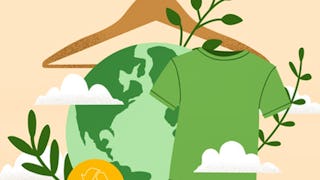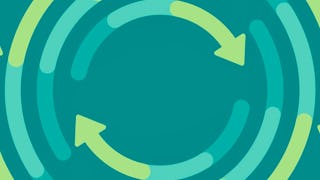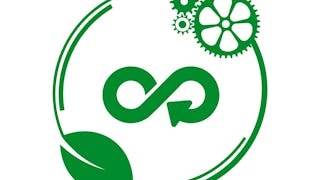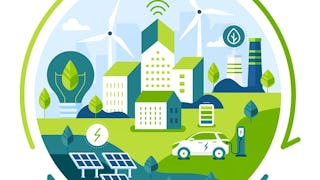The Circular Economy is about zero waste, where products are disassembled into their constituent components, either to be recycled or composted. While considerable attention has focused on the product itself, a product can only be sustainable or circular if the packaging it comes in is also sustainable and circular. This second course in the “Sustainable and Circular Product Development” specialization provides an overview of packaging today, and how it is evolving to become more sustainable. Topics include defining sustainable and circular packaging, packaging as a system, design and functionality, conventional and innovative packaging materials, advances in recycling technologies, and rethinking our approach to packaging.


Packaging Design for the Circular Economy
包含在  中
中
您将学到什么
Make informed purchasing decisions by identifying sustainable and circular attributes of packaging.
Explain the importance and function of packaging.
Describe how packaging is designed and tested.
Explain different packaging materials, from paper to plastic, and the innovative technologies on the horizon.
您将获得的技能
要了解的详细信息

添加到您的领英档案
19 项作业
了解顶级公司的员工如何掌握热门技能

积累特定领域的专业知识
- 向行业专家学习新概念
- 获得对主题或工具的基础理解
- 通过实践项目培养工作相关技能
- 获得可共享的职业证书

该课程共有5个模块
The module begins with an overview of packaging fundamentals, such as what packaging is and why we need it. We then discuss the challenges with packaging, from the amount of packaging that ends up in the landfill to the particular challenges with plastic packaging. The module explains the many functions of packaging, from protection and preservation to communication and sustainability. Finally, the module examines packaging as a system, including primary, secondary and tertiary packaging, as well as how labels play an important role in communication and logistics.
涵盖的内容
9个视频6篇阅读材料4个作业1个讨论话题
Economic growth around the world will lead to greater consumption of stuff, and all that stuff will come packaged in one form or another. In this module, we discuss the 3 pillars of sustainability: People-Planet-Profits, otherwise known as the Triple Bottom Line, and how it relates to packaging. We introduce the concept of the Circular Economy, and its primary tenet that nothing is considered waste - including packaging. We then explore current consumer trends that prefer sustainable and circular packaging, and our collective dislike of plastic packaging. And industry is responding, with innovative approaches to both design and materials. We wrap-up this module examining how we can get from where we are today, to where we need to be tomorrow, highlighting the different approaches to making our packaging more sustainable and circular.
涵盖的内容
8个视频2篇阅读材料4个作业
The principles of the Circular Economy apply to packaging as much as they do to product design. In this module, we discuss packaging design from a packaging engineer's perspective, and the many elements they must consider to ensure the packaging meets business, customer and regulatory requirements. We then go deeper into those elements, including protection, material use, and user-friendliness, to name a few. To understand how these work in practice, several examples are highlighted from companies such as Ikea, Amazon and Puma. Finally, we examine the tools packaging professionals use to design packaging, such as CAD, VR and AR, and the tests used to validate packaging, such as crush tests, drop tests, and atmospheric conditioning. This module lays the groundwork for more sustainable circular packaging design, covered in the next few modules.
涵盖的内容
8个视频5篇阅读材料5个作业
Packaging design relies heavily on material properties to protect the product from structural damage, light and UV damage, as well as intrusion (or leakage) of gases such as oxygen or ethylene. Packaging materials have come a long way, but not necessarily with sustainability in mind. In this module, we explore the mix of packaging materials today, including paper, paperboard and cardboard, glass, aluminum and plastics. We go into each in some detail, highlighting what they are, how they are made, and where the materials are heading in terms of sustainability and circularity.
涵盖的内容
9个视频5篇阅读材料4个作业
Many businesses and consumers are now fully aware of the adverse environmental impacts of packaging. Yet as we often try to do in this course, those challenges create the opportunities for change. In this module, we highlight the innovations occurring in packaging materials, how reuse is possible, and conclude with examples of creative entrepreneurs rethinking packaging altogether. The module begins with advances in biopolymers and bioplastics, highlighting the many exciting advances in the field. There are also several earth-friendly packaging materials on the horizon, including those made from mushrooms and seaweed. Innovation goes beyond materials to business models, where true circularity is achieved by reusing packaging, led by a company that designed robust packaging envelopes suitable for reuse, but also the reverse logistics process to ensure they are reused. The module then introduces several designers reexamining the relationship between product and packaging, and ultimately making both more sustainable. Finally the course wraps up with an optimistic view of the potential for more sustainable and circular packaging, the people and organizations leading the way, and what we can do to accelerate the transition.
涵盖的内容
6个视频5篇阅读材料2个作业
获得职业证书
将此证书添加到您的 LinkedIn 个人资料、简历或履历中。在社交媒体和绩效考核中分享。
攻读学位
课程 是 University of Colorado Boulder提供的以下学位课程的一部分。如果您被录取并注册,您已完成的课程可计入您的学位学习,您的学习进度也可随之转移。
位教师

从 Environmental Science and Sustainability 浏览更多内容
 状态:免费试用
状态:免费试用University of Colorado Boulder
 状态:免费试用
状态:免费试用University of Colorado Boulder
 状态:免费试用
状态:免费试用University of Colorado Boulder
 状态:免费试用
状态:免费试用University of Colorado Boulder
人们为什么选择 Coursera 来帮助自己实现职业发展




常见问题
To access the course materials, assignments and to earn a Certificate, you will need to purchase the Certificate experience when you enroll in a course. You can try a Free Trial instead, or apply for Financial Aid. The course may offer 'Full Course, No Certificate' instead. This option lets you see all course materials, submit required assessments, and get a final grade. This also means that you will not be able to purchase a Certificate experience.
When you enroll in the course, you get access to all of the courses in the Specialization, and you earn a certificate when you complete the work. Your electronic Certificate will be added to your Accomplishments page - from there, you can print your Certificate or add it to your LinkedIn profile.
Yes. In select learning programs, you can apply for financial aid or a scholarship if you can’t afford the enrollment fee. If fin aid or scholarship is available for your learning program selection, you’ll find a link to apply on the description page.
更多问题
提供助学金,






